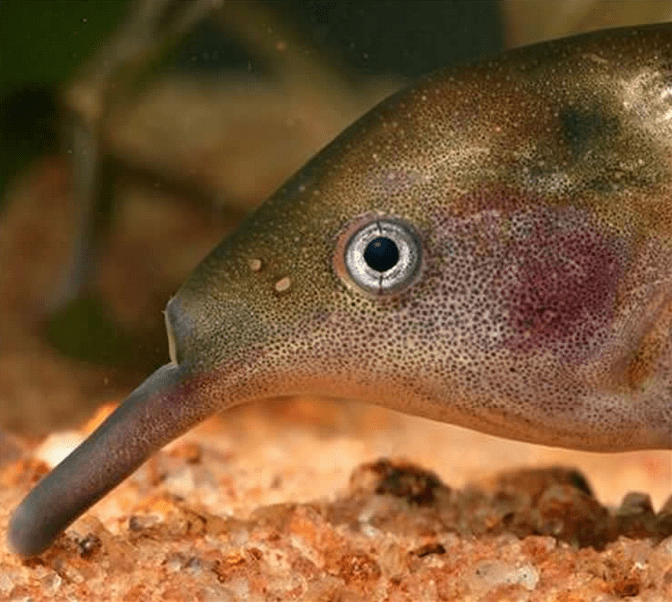Discover the underwater marvel of the elephant nose fish – a captivating species with an elephant’s feature. Let’s uncover the unique traits and behaviors that make this aquatic creature so unique. Here are some facts about elephant fish.
Phylum: Chordata
Class: Actinopterygii
Order: Osteoglossiformes
Family: Mormyridae
Genus: Gnathonemus
They have an elephant trunk
The elephant nose fish is a distinctive freshwater species with a remarkably unique appearance. This fish is known by various common names, including the Ubangi mormyrid, elephant fish, long-nosed elephant fish, and Peters’ elephantnose fish (named in honor of its discoverer). This species is one of the most popular fish in the aquarium.
The fish has a long, slender, almost scaleless body with a dull grey or brown color. Their underbellies tend to exhibit a lighter hue. On its body, you can see subtle white stripes running along the leading edges of both the dorsal and anal fins. Completing its distinctive appearance is a slender, forked tail, often coated in a bold black color.
The elephant nose fish lives up to its name, showcasing a lengthy and pointed snout that closely resembles the trunk of elephants or the striking sword of a swordfish. The curved appendage descends, seamlessly connecting with the fish’s mouth. This distinctive feature enables the fish to explore concealed corners and crevices, looking for food easily.
The full-grown elephant fish has a size of about 9 inches (23 cm), but it reaches up to 14 inches (35 cm).
They use electricity to see
The long snout or “elephant trunk” of this fish is actually called a Schnauzenorgan. This feature isn’t just for show. Functioning as an exceptionally sensitive electroreceptor, it generates faint electric fields and analyzes the distortions produced by objects in the water. This “electric vision” allows the fish to not only navigate but also form a surprisingly detailed 3D image of its surroundings.

Scientists at the University of Oxford found that the fish improves its perception by employing a distinctive “dance,” where it sways its body to observe objects from various angles, thereby acquiring additional information about their shapes.
While the elephant nose fish heavily depends on electrolocation, it is not exclusively restricted to this sense. In contrast to numerous other electric fish, it exhibits remarkably proficient low-light vision, providing a rare advantage in its dim habitat. This capability enables the fish to complement its electric perception and respond to visual cues when needed.
Elephant nose fish habitat
The elephant nose fish lives in the murky waters of several rivers in Africa, primarily the Niger, Ogun, and Chari basins, where it thrives in slow-moving waters characterized by low visibility.
Although the specific natural environment of this fish is unclear, it’s said to prefer regions abundant with vegetation, encompassing roots, aquatic plants, and branches. These elements contribute to the provision of hiding spots, food sources, and comfortable surroundings. A place with a thick substrate (like mud, organic debris, and sand) is also its favorite.

The distinctive physique and sensory capabilities of the freshwater elephant fish are impeccably suited to its habitat. Its elongated snout enables it to access confined spaces and crevices, and its electroreceptive abilities help the fish move in waters with limited visibility. Additionally, its dark coloration helps it blend in the environment, hiding from potential predators.
Diet
Elephant nose fish are bottom feeders. They often eat worms, invertebrates, shrimp, and insect larvae hidden within the vegetation and substrate. In the wild, these fish spend most of their time foraging through the substrate, employing their schnauzer organs to locate and obtain food.
In captivity, you can feed these carnivorous fish earthworms, bloodworms, tubifex worms, small shrimp pieces, and larvae. Vary between various live and frozen food choices. Feed them small amounts three times daily, allowing some food to sink to encourage their natural foraging instincts.
Behavior
Elephant fish are most active at night, but in a dimly-lit aquarium, they are active during the day. This captivating species exhibits an intriguing dual nature in its temperament. When kept as the solitary elephant nose fish in an aquarium, it lives in a harmonious cohabitation with larger, compatible tank mates.

Yet, when you introduce another elephant fish into the tank, everything changes. The fish adopt a territorial demeanor. They become aggressive, showing common behaviors like nipping, chasing, and even the discharge of electric organ activity (EOD) among these fish. Surprisingly, smaller, less assertive fish typically manage to evade such confrontations.
Life cycle
Elephant fish are oviparous, meaning females lay eggs that hatch into fry. Their spawning is said to take place during the rainy season, yet much remains unknown about the specifics of their reproduction.
The lifespan of this fish with a pointy nose is about 6 – 9 years. However, with proper care, they can live up to 11 years.
References:


Wow, I had no idea that elephant nose fish had such unique electrical abilities! Nature never ceases to amaze me.